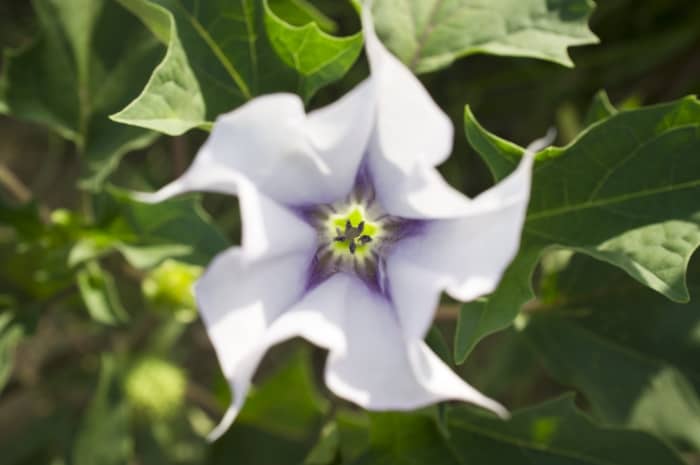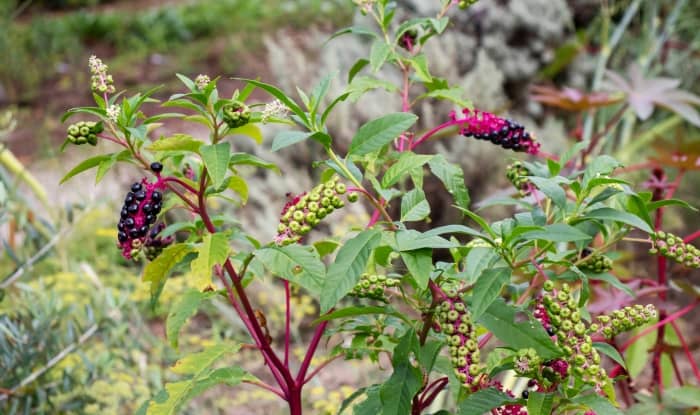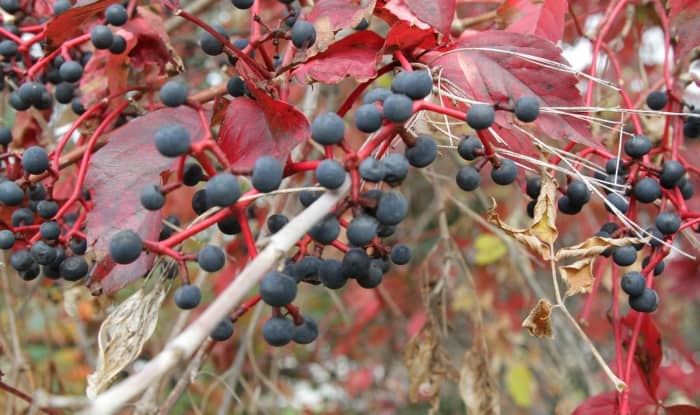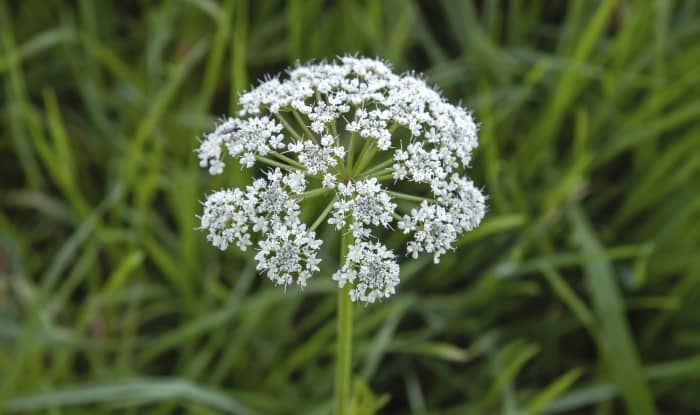Weeds are a nuisance for every gardener. But some weeds go beyond that. Their natural defense mechanisms involve plant toxins that make them dangerous for people, pets, and livestock to consume or sometimes even touch.
To help you recognize these poisonous weeds, we’ve compiled this list of 17 of the most common types you need to know.
Let’s dive in.
Deadly Nightshade (Atropa belladonna)

Also known as belladonna, deadly nightshade is notorious for being a highly poisonous weed. All parts of the plant are toxic. Eating its sweet-tasting berries can be fatal, and even just handling deadly nightshade can make you ill from toxins that pass through the skin. If you’re lucky touching the plant will only lead to severe dermatitis.

Deadly nightshade is most easily identified by its purple bell-shaped flowers, that bloom from June to September. After flowering, the fruit quickly appears, with green berries at first before turning black and shiny, resembling cherries.
The weed has pale green, oval-shaped leaves that are pointed and ribbed. The leaves have smooth edges and grow alternately from the stem.
Deadly nightshade is often seen in woodlands, scrubland, and growing along paths and banks.
Carolina Horsenettle (Solanum carolinense)

Also called devil’s tomato, horsenettle is part of the nightshade family. The weed produces fruit that resemble small tomatoes (1). But be warned, horsenettle is a poisonous weed and the fruit is toxic to eat. Just handling the plant causes a rash for some people.
Horsenettle emerges in the spring. And when fully grown, it reaches 3 ft. tall. Horsenettle weeds develop large thorns on the leaves and stems as the plant grows. The leaves are covered in hairs and have lobed margins. And they’re arranged alternately on the stems.

Horsenettle produces clusters of star-shaped flowers from May to October. Each flower consists of 5 white to pale-violet petals, with yellow anthers at the center.
It’s probably easiest to identify horsenettle by the tomato-like berries it produces. The berries are round and about ½-inch in diameter. And turn from green to yellow as they mature.
Italian Arum (Arum Italicum)

Italian arum is a herbaceous perennial. Originally an ornamental plant, Italian arum is now considered an invasive weed in some US states because of its rapid spread and difficulty to control.
The weed grows well in most soil types but prefers moist soil. And it thrives in partial shade to full sun.
In the summertime, the weed has distinctive orange-red berries that grow on an erect central fleshy stem. The berries are poisonous to humans and animals.

The leaves are glossy and grayish-green with white veins and long petioles. The leaves are shaped like an arrowhead and die back after the plant blooms before new leaves emerge in the fall. Between April and May, Italian arum produces creamy white flowers.
All parts of the Italian arum plant are toxic, and touching the weed can cause skin irritation.
Bittersweet Nightshade (Solanum dulcamara)
The bittersweet nightshade plant is also known as blue bindweed, bitter nightshade, poison berry, and climbing nightshade. Bittersweet nightshade is a perennial woody vine that grows up to 10 ft. in length and climbs when there’s adequate support.
All plant parts are toxic, and the noxious weed produces clusters of poisonous bright red berries in the fall. Ovate leaves grow alternately on the stiff stems. The leaves are dark green and sometimes purple-tinged and reach between 2-4 inches long. From May to September, the plant produces small bright purple flowers with eye-catching yellow anthers that hang in clusters.
Bittersweet nightshade spreads by seeds and can grow from stem and root fragments. You’ll often find this weed growing around field edges, gardens, parks, roadsides, and wetlands as the plant likes moist soil.
Bittersweet nightshade is toxic. Although not the same plant as deadly nightshade or as dangerous, it can cause sickness in animals and children that eat its berries, sometimes fatal.
Poison Hemlock (Conium maculatum)
Of all the weeds to find growing in your garden, this is one of the least welcome. Also known as deadly hemlock, spotted hemlock, and poison parsley, poison hemlock is a noxious weed with a famous reputation for being highly toxic.
All parts of this weed are poisonous when eaten, and even a small amount can be fatal. Be careful when handling the plant as the toxins can cause severe skin reactions, and even dead canes retain their toxicity for up to three years. Besides humans, poison hemlock is poisonous to cats, dogs, sheep, cattle, horses, chickens, and goats.
The toxic compounds are coniine, g-coniceine, and related piperidine alkaloids. People may be poisoned by eating any part of a hemlock plant. Often, poisoning occurs after the victim confuses hemlock root with wild parsnips, hemlock leaves with parsley, or hemlock seed with anise.
USDA Agricultural Research Service (2)
The plant stems have reddish-purple streaks or spots and are smooth and hollow. The bright green leaves are fern-like with toothed edges and are particularly poisonous in the spring. When poison hemlock blooms, the plant produces clusters of tiny, white flowers with 5 petals. The flowers develop into green fruit.
Poison hemlock is a biennial that usually grows for two years. But in good locations, it’s sometimes a perennial weed. Poison hemlock often grows in open sunny areas. It’s common to see it growing in vacant lots, fields, alongside roads, and at the edge of cultivated land.
Lupines (Lupinus spp.)
Many lupine species are poisonous, causing a problem in areas with grazing livestock that risk poisoning after eating lupine pods and seeds. Younger plants are generally more poisonous than older plants, containing a higher concentration of toxic alkaloids that can also cause birth defects in cattle. But lupine hay also retains toxicity.
Common poisonous species of lupine include, yellow lupine (L. sulphureus), silky lupine (L. sericeus), velvet lupine (L. leucophyllus), silvery lupine (L. argenteus), tailcup lupine (L. caudatus), lunara lupine (L. formosus).
Lupine leaves are palmate-compound with up to 28 leaflets. The small flowers grow around an erect spike and vary in color. You can find the flowers in blue, white, pink, yellow, or blue and white. The plants produce seedpods, each containing several seeds, which explode to disperse their contents close to the plant.
Lupines thrive in dry, nutrient-deficient soils where many other plants struggle. It’s common to find lupines growing in rangelands, pasture, dunes, grasslands, and hillsides.
Oleander (Nerium oleander)
Oleander is originally native to the Mediterranean region and is sometimes planted as an ornamental evergreen shrub in the United States and other parts of the world. But it’s also now considered an invasive and noxious weed in many locations.
Oleander is a fast-growing plant that can grow up to 6 m tall. The lance-shaped, leathery leaves grow opposite each other and sometimes in whorls of three. At the end of the branches, clusters of beautiful flowers grow in yellow, white, red, coral, or pink, depending on the oleander variety.
All parts of oleander are extremely poisonous, with the highest concentration of dangerous cardiac glycosides occurring in the leaves and flowers (3). A single leaf contains enough poison to kill an adult. Don’t try to dispose of the plant by setting it on fire because the smoke is also toxic.
Oleander grows easily in a variety of soil types and a range of conditions. The plant is drought tolerant and likes full sun but will grow in partial shade.
Rosary Pea (Abrus precatorius)
Rosary pea is originally a native of India and tropical Asia but is used as an ornamental plant in parts of the United States and is now also classified as an invasive and noxious weed in some areas.
The weed produces one of the most potent plant toxins, a protein called abrin. Abrin is found in the bright red seeds of rosary pea and is similar to ricin in the castor bean plant. Just one well-chewed seed is sufficient to kill an adult.
The pinnately-compound leaves of the plant grow alternately from the stem on petioles reaching 2.5 inches long. Each leaf consists of 5-15 pairs of leaflets under 1-inch long and oval to oblong shaped. Dense clusters of small flowers grow out of the leaf axils and can be pink, violet, or white. The seed pod contains 3-8 hard shiny seeds.
Rosary pea is a woody vine that twines around native plants and obstacles, allowing the weed to climb even though it doesn’t have tendrils. You’ll often find it growing around fence rows and disturbed sites such as roadsides and pastures. But it also invades undisturbed hammocks and pinelands in Florida.
Jimson Weed (Datura stramonium)

Jimson weed is an invasive weed that’s a member of the nightshade family. It’s also known as thorn apple and devil’s snare.
Jimson weed produces a large fruit encased in a spiky capsule. But be careful not to eat it. Jimson weed is a notorious poisonous weed that’s dangerous when ingested. And just touching the plant can cause rashes. Making it an unpleasant weed to have growing in your garden.

Jimson weed is a big weed that grows up to 6.5 ft. tall. The plant has green stems that are sometimes purple-tinged. And alternating leaves with toothed edges.
The plant blooms in summer. With trumpet-shaped violet or white flowers up until the first frost.
Giant Hogweed (Heracleum mantegazzianum)

Giant hogweed is a perennial flowering shrub that originated in the western Caucasus region of Eurasia but has now spread around the world. First as an imported ornamental plant. And now as a noxious weed.
In the right conditions, the plant can grow 18 ft. tall. With a stiff tall stalk that grows up to 10 cm thick and 13 ft. high. When it blooms, you can see multiple clusters of white flowers growing from short stalks up into the air. They grow out from a central point, resembling an umbrella.

A fully grown plant has gigantic, deeply lobed leaves that can grow up to 5 ft. wide.
It’s sometimes mistaken for similar-looking plants such as cow parsnip, woodland angelica, purple stem angelica, lovage, valerian, and Queen Anne’s lace.
But giant hogweed grows much taller than any of these. And the stalk has reddish-purple spots and coarse bristles. None of the lookalikes have both of these.
You should wash your hands immediately if you touch hogweed because it can be harmful. The watery sap is phototoxic and can cause serious burns if you expose your skin to sunlight.
Pokeweed (Phytolacca Americana)

Pokeweed is a large and problematic perennial broadleaf weed. Pokeweed is an invasive weed because it can spread rapidly in an area, growing in dense, tall bushes that crowd out and displace other plants.
You can easily identify pokeweed when it bears fruit. Pokeweed has attractive, dark-purple berries that are tempting to eat, but make sure you don’t. Every part of pokeweed is poisonous, including the berries.
Children who eat a berry or two are not likely to develop symptoms. Eating several berries, though, can cause a lot of stomach distress: pain, nausea, vomiting, and diarrhea. Adults have eaten the roots, mistaking them for medicinal plants. Serious gastrointestinal problems have occurred, including bloody vomiting, bloody diarrhea, and low blood pressure.
Poison.org (4)
Pokeweed is sometimes used as a traditional folk remedy for skin complaints, joint pains, and tonsilitis. But this isn’t a safe weed to use for medicinal purposes.
The fruit contains seeds that help the weed to spread. So even if you don’t remove the plant, it’s worth removing the fruit, especially if you have young children who might put the berries in their mouths.
When pokeweed isn’t producing fruit, you can recognize the weed by its thick hollow red stems, green-white flowers, and large green leaves with long petioles.
Poison Ivy (Toxicodendron radicans)

You can find poison ivy growing as a climbing vine, a shrub, or a groundcover. The vine has reddish stems and leaves that grow alternately, each leaf consisting of 3 leaflets. Young poison ivy plants often have reddish leaves in the spring that turn green in the summer. You can find poison ivy growing in shady and sunny areas of your yard, with vines that sometimes reach 100 ft.

Be careful when handling poison ivy. It’s a noxious weed that contains an oily resin called urushiol that causes a rash if it gets on your skin.
Poison Oak (Toxicodendron diversilobum)
Poison oak is a woody perennial weed well known for its toxic nature. Like poison ivy and poison sumac, the plant contains the oil urushiol that causes an allergic reaction upon contact, resulting in an itchy skin rash.
Poison oak usually grows as a dense, leafy shrub in open, sunny places. The shrub can grow up to 6 ft. tall. In shady areas, it’s common to find poison oak growing as a climbing vine, sometimes reaching 75 ft. or more, that supports itself with aerial roots as it grows over obstacles and vegetation.
The leaves consist of 3 leaflets, each 1-4 inches long. The edges of the leaves are toothed or lobed and vary from glossy to dull and leathery to thin. The leaves grow alternately along the stem. In the autumn, the leaves turn red and contain a higher concentration of urushiol. When poison oak blooms, it produces small white-green flowers that grow from leaf axils.
Poison oak spreads by seeds and rhizomes and vines that touch the ground can root and aid the plant’s lateral expansion. Poison ivy often grows in residential areas in gardens and parks. You’ll also come across it growing in woodlands, brushlands, coastal areas, and rangelands.
Poison Sumac (Toxicodendron vernix)

Poison sumac is a perennial broadleaf shrub or small tree that most people consider a weed tree, as nobody wants this plant growing on their property.
The big problem with poison sumac is given away by the name: every part of the plant is toxic. Similar to poison ivy, poison sumac produces urushiol, an oil that causes an allergic response when it comes into contact with your skin. Urushiol is released by the plant whenever it’s crushed or bruised.

You can identify poison sumac by its red stems. Each stem has 7-13 smooth-edged leaves with sharp points growing in opposite pairs. When it blooms in June, the plant produces clusters of small yellow-green flowers, and eventually develops large clusters of green berries that hang from the stems and turn white in the fall.
Castor Bean (Ricinus Communis)

Also known as the castor oil plant, Ricinus communis is a fast-growing perennial shrub, growing up to 10 ft. a year up to 40 ft. tall. The weed produces large glossy green leaves growing alternately from long red stems that branch from a thick central red stalk. Long petioles connect the leaves to the stem.

The plant produces dense clusters of red flowers at the top of the stems and seed capsules about the size of a golf ball that can be pink, red, or green. Soft spines cover the seed capsules, and each contains three seeds that eject when the seedpod splits open.
The seeds are extremely poisonous, containing a protein toxin called ricin. Just a couple of chewed seeds can be fatal. So don’t allow a castor bean plant to flower and seed in your garden if you have children or pets.
Virginia Creeper (Parthenocissus quinquefolia)

Virginia creeper is a perennial woody vine weed often found around orchards, vineyards, and gardens.
Virginia creeper is a fast-growing vine that’s sometimes mistaken for poison ivy. But unlike poison ivy, Virginia creeper has five leaflets making up its compound leaves that taper to a pointed tip with saw-toothed edges. And Virginia creeper doesn’t produce urushiol oil, the skin irritant that poison ivy is notorious for. But it does produce sap that causes a skin rash in highly sensitive people.

Virginia creeper grows well in full sun to full shade and can climb up to 30 ft. with adhesive pads at the end of tendrils holding the vine in place. When Virginia creeper blooms, it produces clusters of yellow flowers at the end of green-red stalks.
In the fall, Virginia creeper leaves turn red, and the flowers give way to dark blue-black berries at the end of the now bright red stalks. The berries are poisonous, so don’t eat them. But every part of the plant is toxic, containing oxalate crystals. In particular, the seeds, seed pods, and leaves have high oxalate crystal levels.
Sacred Bamboo (Nandina domestica)

Sacred bamboo is also known as heavenly bamboo or nandina. This plant is an invasive weed that originated in East Asia and is often sold in garden centers and nurseries in the US as an ornamental.
Sacred bamboo is an evergreen shrub that grows between 6-10 ft. tall and 3-5 ft. wide. The plant has many shiny dark-green stems that resemble bamboo stalks. Growing alternately from the stems are large bi-pinnately compound leaves consisting of many small leaflets that are pointed and oval-shaped. Young leaves are sometimes pinkish before turning light green as the plant matures and often develop a red tinge in winter.

In the summer, clusters of tiny white flowers develop at the end of the stems. The flowers give way to shiny red berries, visible in the fall and winter. The berries are poisonous to people and wildlife.
Sacred bamboo is a shade-tolerant plant that you’ll often see growing in forests, where it forms dense groves and displaces native plants. But the weed also grows in full sun.
References:
- Horsenettle – https://mdc.mo.gov/discover-nature/field-guide/horse-nettle
- Poison Hemlock – https://www.ars.usda.gov/pacific-west-area/logan-ut/poisonous-plant-research/docs/poison-hemlock-conium-maculatum/
- Oleander – https://weeds.dpi.nsw.gov.au/Weeds/Oleander
- Pokeberries: A Grape Look Alike – https://www.poison.org/articles/pokeberries-and-grapes-look-alike















I have weed in my glasshouse with large 4ins. leaves borne in 3s , white flowers followed by green berries that ripen very dark purple. It seems to be eaten by birds and excreted all over my nurseries. It grows very fast and has appeared for the first time this year in profusion. As I have dense foliage round my glasshouse it is very hard to trace the source the birds are eating from. Can tou shed any light on its name and a possible cure.
Kind Regards Laddie